Simple Living vs Minimalism What’s the Difference?
Ever wondered what sets simple living apart from minimalism? While they are on the same intentional living spectrum there is a difference. Keep reading to learn all about them and see which one is best for you!
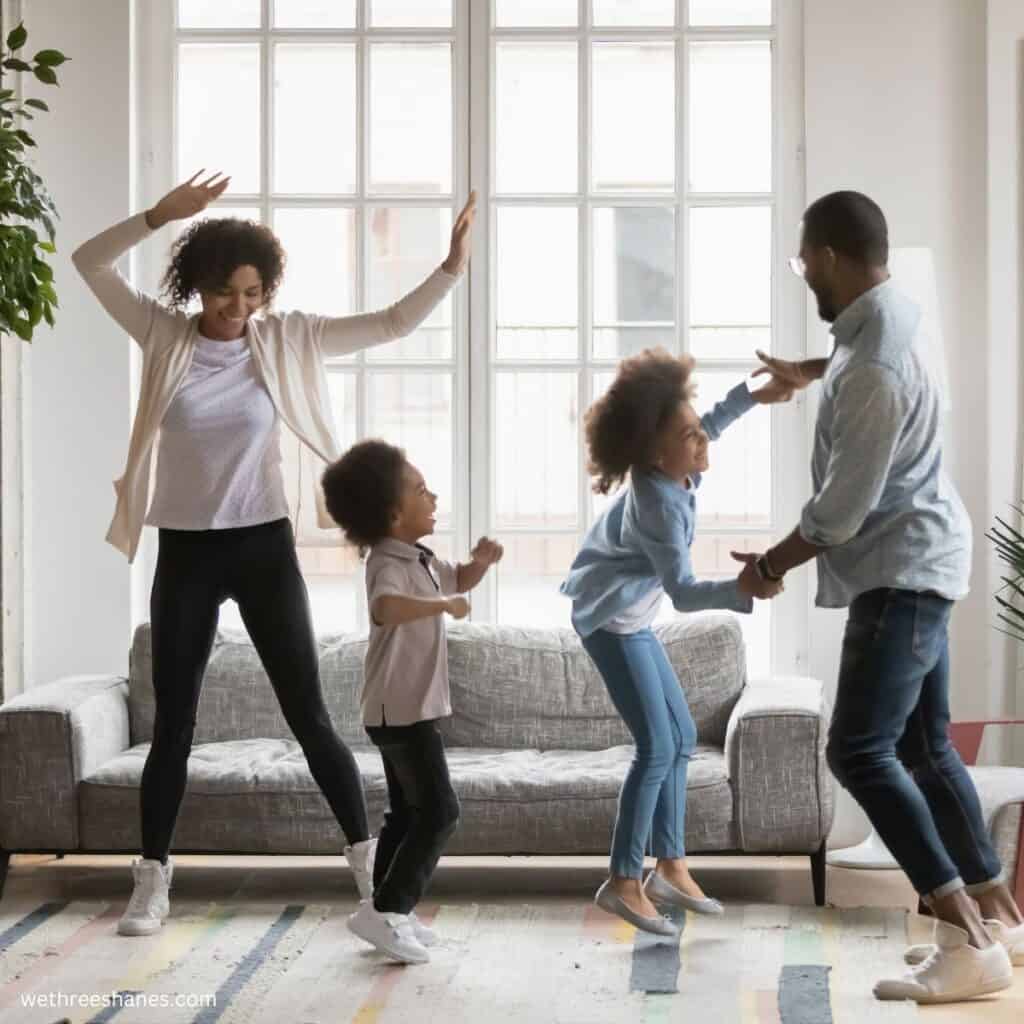
(THIS POST PROBABLY CONTAINS AFFILIATE LINKS. OUR FULL DISCLOSURE POLICY IS LONG & BORING BUT, YOU CAN FIND IT HERE.)
Simple Living vs Minimalism
Alright, let’s straighten this out—simple living and minimalism? Not exactly cut from the same cloth, but folks often toss them into the same laundry basket. It’s like comparing a cozy cabin retreat with a sleek, modern home. Sure, they share the same real estate market, but the vibes are worlds apart.
Simple living is your laid-back aunt who’s all about balance and vibes. It’s about finding your groove in a world that’s spinning a little too fast. You declutter your schedule, toss out the non-essentials, and voilà, more time for the good stuff.
Simple living doesn’t mind a few extra cozy blankets or a shelf of well-loved books. It’s about values, experiences, and rocking a life that feels just right.
Now, minimalism, on the other hand, is like that one friend who’s got a wardrobe straight out of a black-and-white movie. It’s the pursuit clear spaces and the art of saying “no” to unnecessary stuff and baggage.
Minimalism rocks the capsule wardrobe, the clutter-free countertops, and a room so tidy you could host a dance party in it. It’s less about the cozy, more about the curated. Quality over quantity, less is more, you get the gist.
So, why the mix-up? Probably because both are on the same spectrum of intentional living and there are certain elements that can crossover into different areas of your life. So, let’s talk more about those.
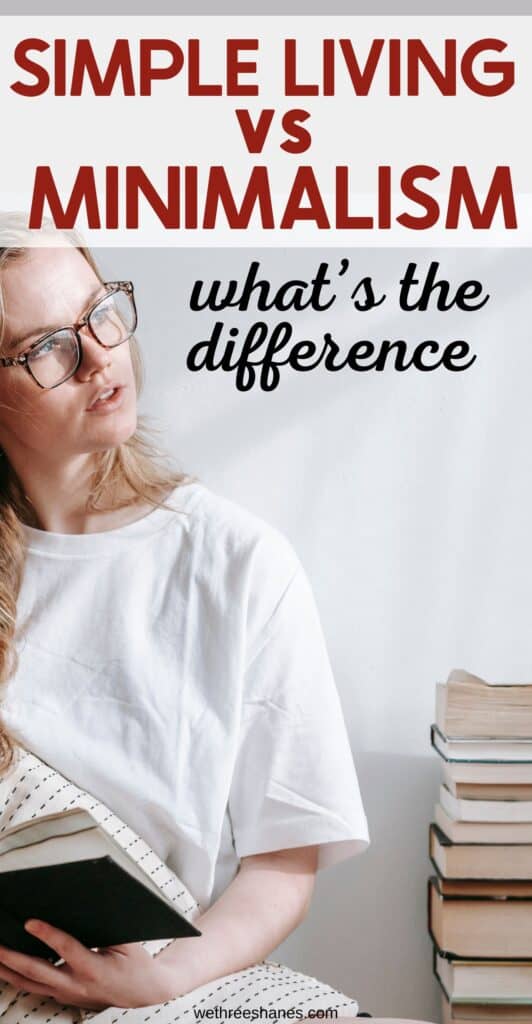
What Does Simple Living Mean?
Imagine sitting down with your best friend and having a heart-to-heart conversation about life while eating your favorite dessert. That’s what simple living is all about.
It’s a conscious decision to step back from the hustle and bustle, the constant rush, and the never-ending quest for more. Instead, it’s about choosing a life that’s uncluttered, intentional, and aligned with your deepest values and desires.
In a world that often promotes materialism and busyness, a simple lifestyle encourages you to declutter your physical and mental space. It’s not just about getting rid of stuff, but about making room for what truly matters.
You focus on experiences, relationships, and personal growth rather than the accumulation of possessions. By simplifying, you free yourself from the burden of excess, reduce stress, and gain the freedom to live a life that’s uniquely your own.
You focus on the important things so you can live a meaningful life.
It’s a path to greater contentment, mindful choices, and a deep appreciation for the simple joys in life. Simple living is like taking a step back to savor the beauty of life’s essentials and embrace a more meaningful and fulfilling way of living.
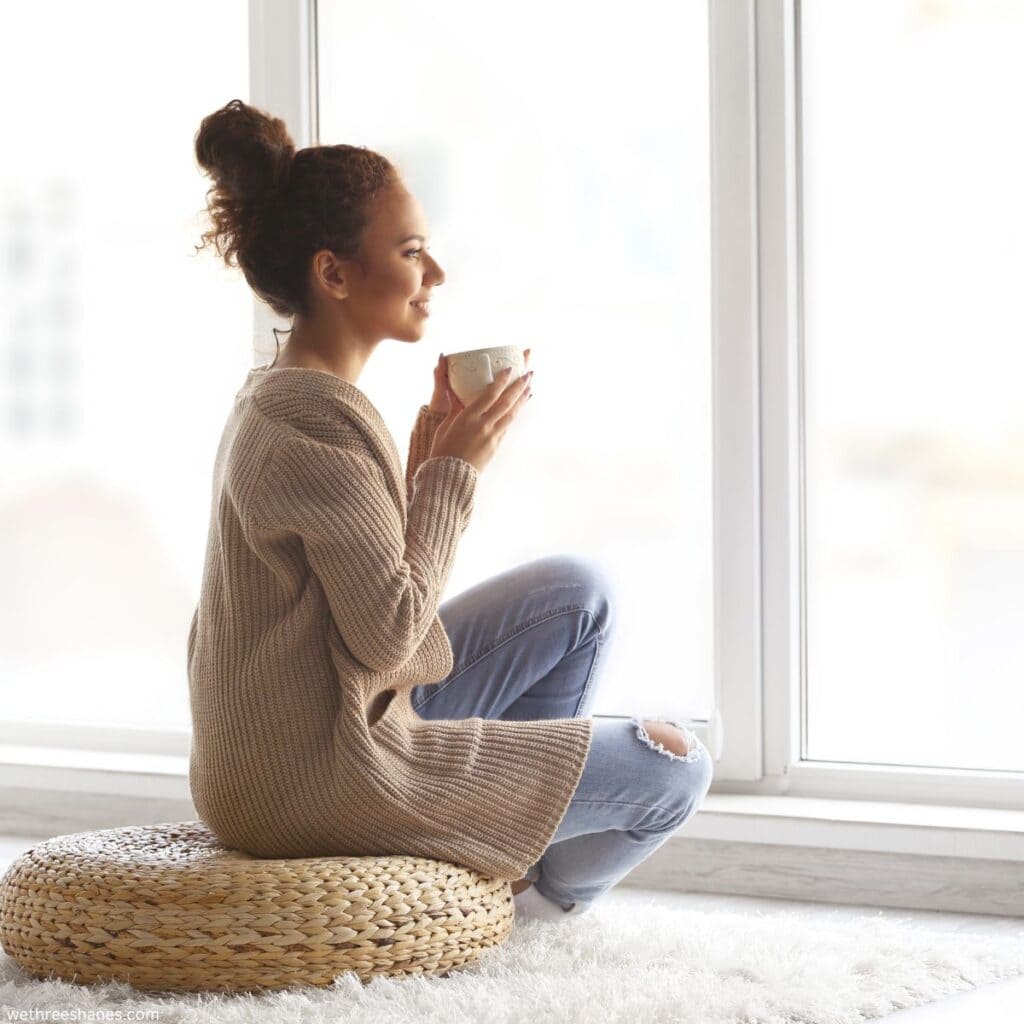
Simple Living Might Be For You If…
If your to-do list is a never-ending scroll, if you find yourself nodding yes to every request, and your schedule feels like a maze with no exit, you can’t remember the last time you sat at the dinner table with your family, then simple living might be your ticket to reclaiming your time and rediscovering the things you truly love.
It’s for those who’ve mastered the art of juggling a dozen tasks but have forgotten what it feels like to just be. Simple living is like a gentle nudge, urging you to pare down the excess, declutter not just your space but your overloaded calendar.
If the idea of saying no to the unnecessary, carving out moments for what brings you joy, and embracing a slower, intentional pace sounds like a remedy for your always-on-the-go life, then simple living is your call to simplicity—an invitation to untangle from the chaos and savor the sweetness of a more balanced and fulfilling existence.
What is Minimalism
Imagine walking into a room with clean lines, open spaces, and just a few carefully chosen items that serve a specific purpose or bring you joy. That’s the essence of minimalism.
It’s an intentional way of living that encourages you to pare down your belongings to the absolute essentials and eliminate excess. Minimalism is like a deep breath of fresh air in a world often filled with consumerism and the relentless pursuit of more.
At its core, minimalism is about quality over quantity. It’s about owning things that truly add value to your life and letting go of the rest.
By decluttering your physical environment, you not only create a visually soothing space but also a mental one. With fewer distractions and less stuff to manage, you gain a sense of clarity and focus.
Minimalism is also about letting go of the attachment to material possessions, understanding that your happiness isn’t tied to the accumulation of things.
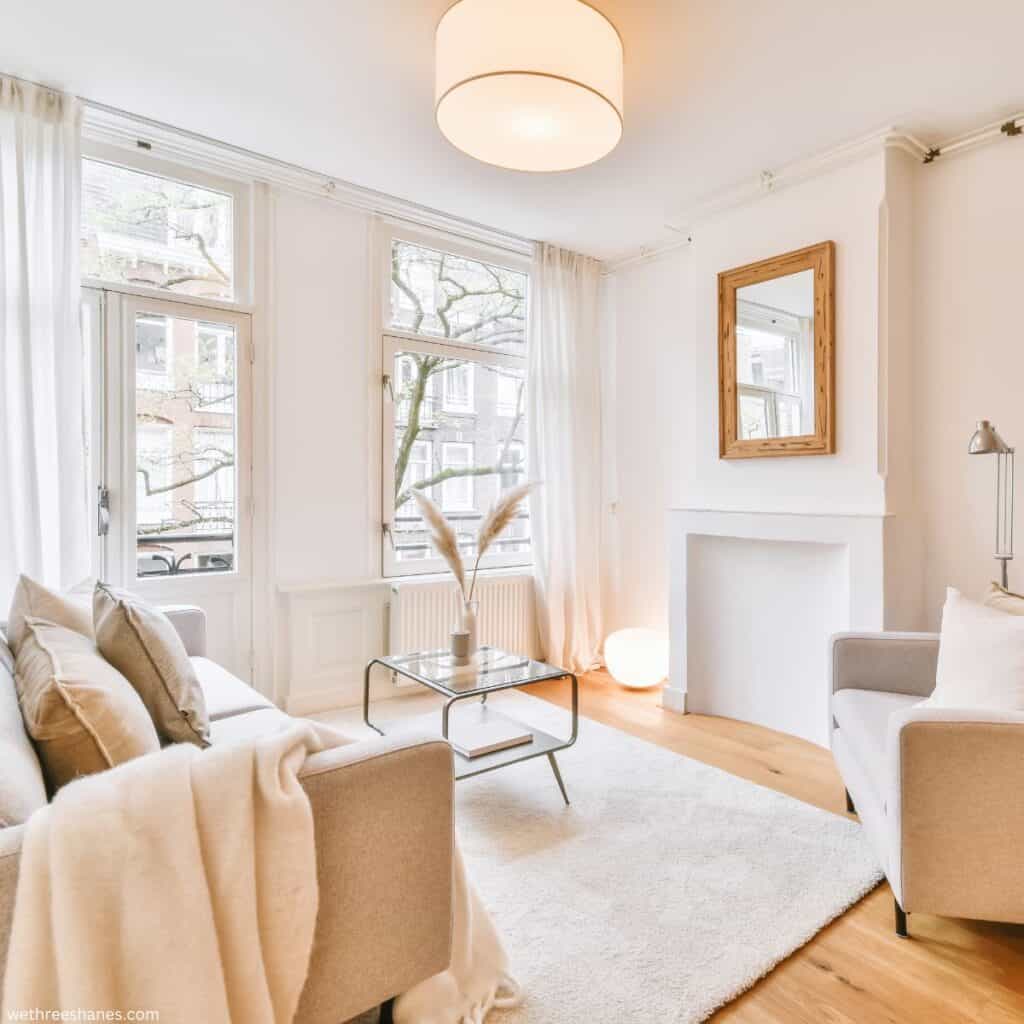
You Might Want To Give Minimalism a Try If…
If every surface in your home is in a constant battle with clutter, you can’t open a cupboard without something falling out, you can’t walk through your kids room without stepping on a toy, minimalism might be for you.
You might enjoy a more minimalist lifestyle if you’ve got too much stuff and not enough storage space, and flat surfaces are piled high with a lot of stuff because they don’t have a permanent place in your home. If you’ve mastered the art of navigating a sea of belongings just to find your keys, and the thought of a serene, the clutter-free countertop feels like a distant dream.
If you spend too much time cleaning and less time relaxing and enjoying the little things in life then minimalist living might be for you. A minimalist life leads to less stress by reducing the mental and physical clutter in our lives, allowing for simplified decision-making, increased focus, and a more tranquil living environment.
It’s not just a benefit to you. A minimalist mindset is good for the whole family.
For children, growing up in a minimalist environment teaches valuable lessons about conscious consumption, gratitude, and the importance of relationships over materialism. It also makes it much easier for kids to clean up after themselves because there is less stuff to put away and helps with decision fatigue.
Overall, minimalism creates a harmonious atmosphere that promotes well-being and togetherness for every member of the family.
You don’t need a bigger house to have a good life. You just need less stuff.
What’s the Difference Between Simple Living and Minimalism?
Simple living and minimalism are related concepts, but they are not the same. They both advocate for a deliberate and intentional approach to life, but they focus on different aspects and have distinct philosophies. Here’s an overview of the differences between simple living and minimalism:
Simple Living:
Here’s a quick look at what simple living is:

1. Lifestyle Philosophy: Simple living is a broader lifestyle philosophy that encourages people to live a life of balance, contentment, and purpose. It emphasizes the importance of focusing on what truly matters, which can include relationships, personal well-being, and community. Choose your favorite thing and then make time to do more of it. Your everyday life should be filled with things you love not just things you have to do.
2. Emphasis on Values: A simple life often revolves around aligning one’s life with their core values. It encourages people to evaluate what is essential to them and make choices that reflect those values.
3. Holistic Approach: Simple living encompasses various aspects of life, such as relationships, work, leisure, and personal development. It’s about finding a harmonious balance in all these areas.
4. Less Consumption: While it may involve decluttering and reducing material possessions, simple living is not solely focused on material possessions. It also considers simplifying commitments, time management, and overall busyness.
5. Sustainability: Simple living often promotes sustainable practices and eco-friendly choices as part of its broader commitment to living in harmony with the environment.
Principles of Minimalism:
Here’s a quick look at what minimalism is:
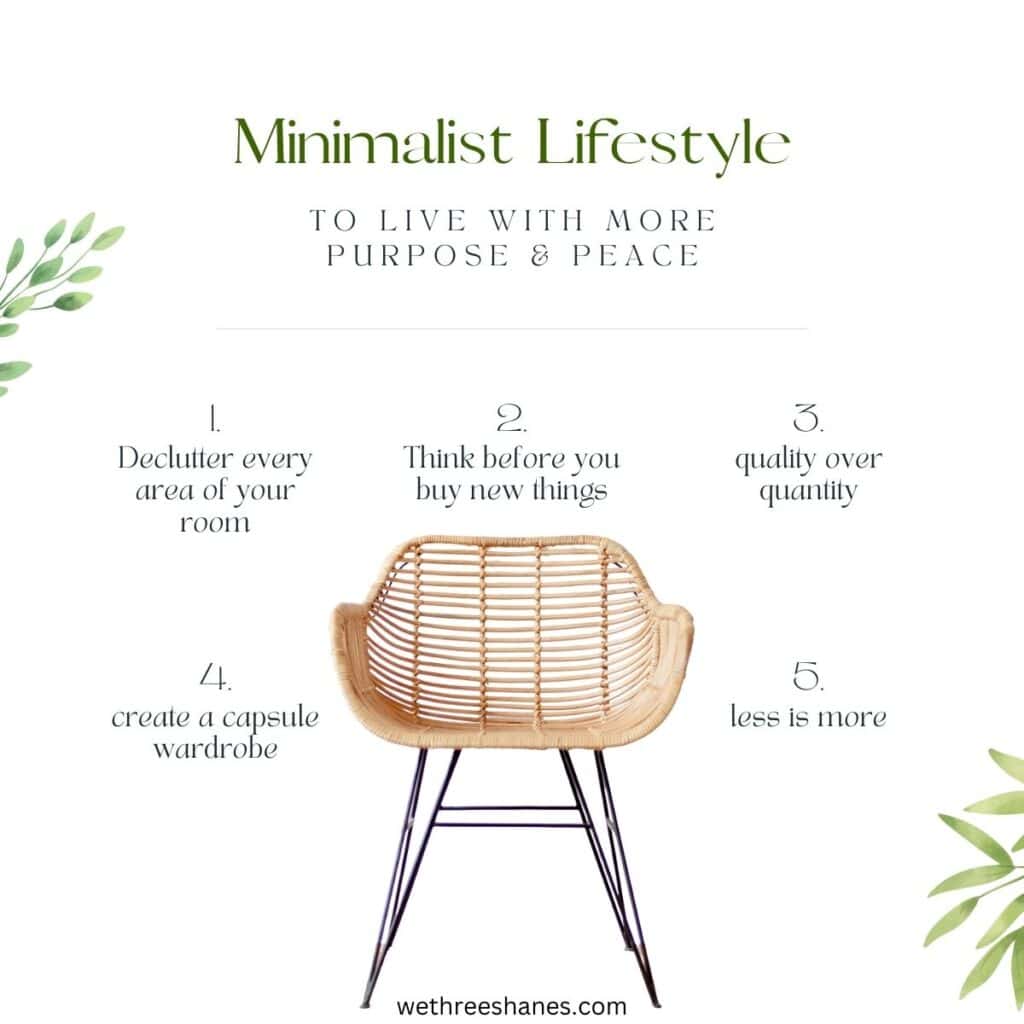
1. Lifestyle Choice: Minimalism is a more specific lifestyle choice that centers around reducing material possessions and living with the bare essentials. It’s often associated with decluttering and simplifying one’s physical environment.
2. Emphasis on Material Possessions: Minimalism primarily focuses on material possessions and the idea that having fewer things can lead to greater freedom, reduced stress, and increased happiness.
3. Simplicity in Aesthetics: Minimalism often translates to minimalist aesthetics in design, architecture, and fashion, emphasizing clean lines, simplicity, and functionality.
4. Decluttering and Organization: Minimalism encourages decluttering, organizing, and only holding onto items that have a clear and purposeful role in one’s life.
5. Quality Over Quantity: Minimalists tend to prioritize the quality of possessions over quantity, often investing in higher-quality items that are built to last.
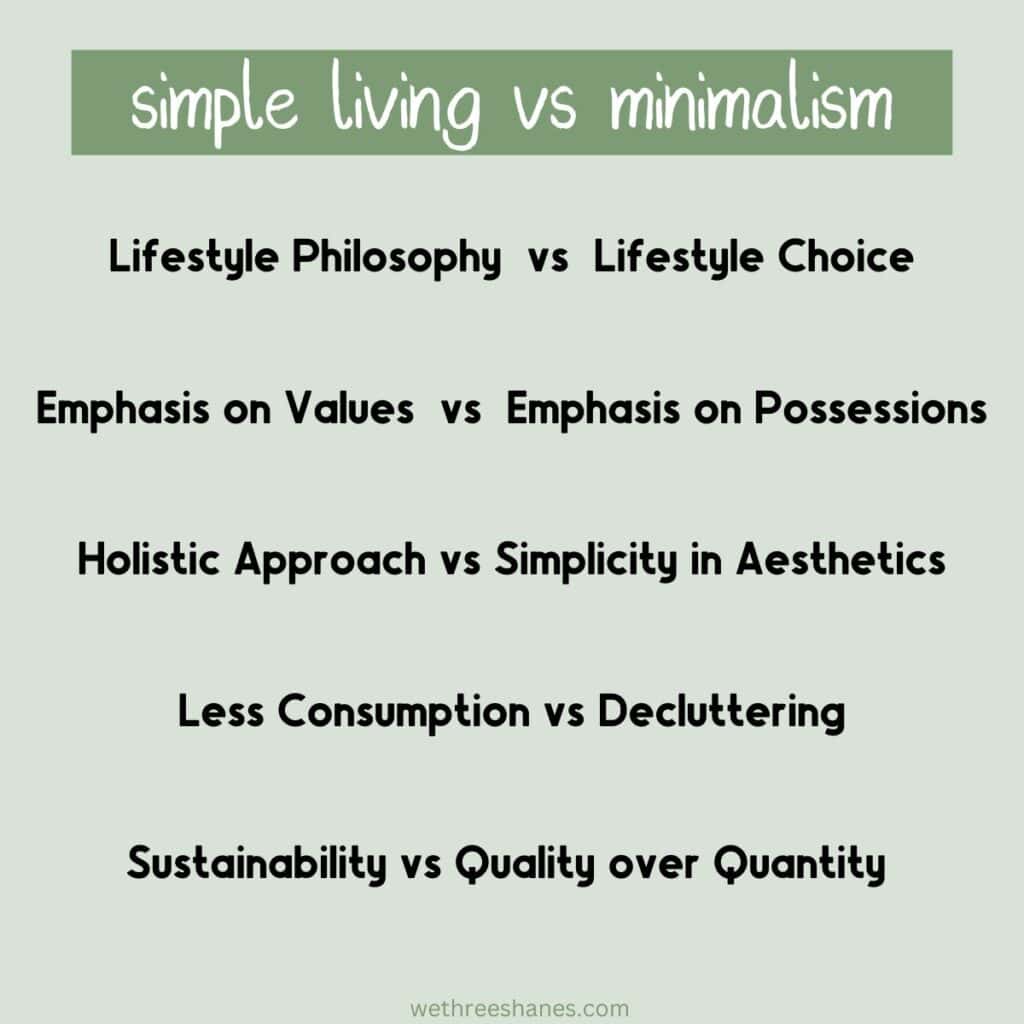
In summary, simple living is a holistic lifestyle philosophy that encompasses a broader range of values and aspects of life, while minimalism is more specific and primarily focuses on decluttering, reducing material possessions, and embracing simplicity in one’s immediate environment. However, individuals often combine elements of both philosophies to create a lifestyle that suits their personal values and goals.
How Do Simple Living and Minimalism Work Together?
Simple living and minimalism are often complementary philosophies that can go hand in hand, but they aren’t the same. When combined, they can create a powerful approach to living a more intentional and fulfilling life. Here’s how they can work together:

1. Reducing Material Possessions: Both simple living and minimalism encourage reducing the number of material possessions you own. Minimalism focuses on owning only what is essential or brings joy, while simple living promotes having fewer material distractions to focus on what truly matters.
2. Prioritizing Values: Simple living starts with identifying and prioritizing your core values. Minimalism supports this by allowing you to eliminate possessions that don’t align with those values. You keep what matters most and remove what doesn’t.
3. Decluttering and Organization: Minimalism’s emphasis on decluttering can help you simplify your living space, making it easier to maintain and enjoy. This aligns with the idea of simple living, which encourages a life unburdened by unnecessary clutter.
4. Stress Reduction: Both philosophies aim to reduce stress. Minimalism does this by reducing physical and mental clutter, while simple living encourages a slower, more intentional pace of life, which can lead to reduced stress and anxiety.
5. Mindful Consumption: Minimalism promotes mindful consumption, encouraging you to think critically about your purchases. Simple living supports this by promoting responsible and conscious spending.
6. Quality Over Quantity: Minimalism often encourages owning high-quality possessions. Simple living can extend this to the quality of experiences, relationships, and commitments, emphasizing depth over quantity.
7. Environmental and Financial Benefits: Both philosophies often lead to sustainability and financial freedom. Owning fewer things reduces your environmental footprint, and spending less on unnecessary items can lead to better financial security.
8. Focus on What Matters: The core of both simple living and minimalism is focusing on what truly matters in life—be it relationships, personal growth, community, or experiences. By minimizing distractions and non-essentials, you create more room for these meaningful aspects.
While simple living and minimalism have their unique emphases, many people find that by incorporating elements of both into their lifestyle, they can achieve a balanced, intentional, and more satisfying way of life. The combination allows for a streamlined, purpose-driven existence that is not overwhelmed by materialism or excess while emphasizing deeper connections and personal fulfillment.
Why You Might Want to Start With Simple Living Instead of Minimalism
Starting with simple living rather than minimalism can be easier for several reasons, and it often serves as a gentler introduction to a more intentional and fulfilling lifestyle. Here’s why simple living might be an easier starting point:
1. Less Drastic Change: Simple living doesn’t require you to completely eliminate possessions or adopt an extreme minimalist lifestyle right away. It allows for a gradual transition, which can be less overwhelming and easier to adapt to.
2. Focus on Values: Simple living begins by helping you identify and prioritize your core values. It’s a process of self-discovery and reflection, which doesn’t demand immediate purging of possessions. This emphasis on values can guide your choices and make it easier to decide what to keep and what to let go of once you’re ready.
3. Holistic Approach: Simple living encourages you to simplify various aspects of life, not just material possessions. It encompasses relationships, work, time management, and personal development. This holistic approach means you can make changes in different areas of life at your own pace.
4. Reduced Stress: The initial focus in simple living is often on reducing stress and busyness. This can have immediate, positive effects on your well-being. By creating space in your life, you can alleviate stress without necessarily parting with many possessions.
5. Emphasis on Sustainability: Simple living frequently aligns with sustainability and eco-conscious choices. You can start with eco-friendly practices, such as reducing waste and consuming responsibly, without fully embracing minimalist aesthetics.
6. Less Pressure to Declutter: While decluttering is an essential part of both lifestyles, simple living doesn’t push you to declutter as aggressively or rigorously as minimalism might. You can declutter at your own pace and comfort level.
7. Emphasis on Relationships: Simple living often emphasizes the importance of deeper connections and relationships. This focus can provide a more tangible and emotionally rewarding starting point for many people.
8. Balanced Approach: Simple living is often seen as a balanced, middle-ground approach between a cluttered, consumer-driven life and an extreme minimalist one. It allows you to navigate your own unique path towards a simpler life.
By starting with simple living, you can gradually ease into the concepts of intentional living, reduced clutter, and a focus on what truly matters. It’s an approach that encourages you to go at your own pace and adjust to the changes more comfortably, ultimately making the transition towards minimalism, if desired, feel like a natural progression.
Where to Start with Simple Living and Minimalism
Discovering your core values is a crucial part of simple living. Start by reflecting on what truly matters to you in life. What brings you joy, fulfillment, and a sense of purpose?
Consider the people, activities, and principles that resonate with you on a deep level. Ask yourself what you want to prioritize and emphasize in your life. Make a list of the things that bring you a genuine sense of happiness and contentment.
As you navigate through this process, you’ll begin to identify your core values, providing a solid foundation for simplifying your life in alignment with what truly matters to you.
Check out our best posts about Simple Living:
The Many Benefits of Living a Simple Life
Slow Down and Enjoy Life With These Simple Living Quotes
The Science Behind Simple Living
You will eventually need to declutter your physical space. Lucky for you we have plenty of articles on the topic.
Check out some of our most popular posts about Decluttering!
The Last Decluttering Guide You’ll Ever Need
Declutter Faster With These Tips & Tricks
How to Declutter Your Bedroom, and Why You Should
20 Reasons Your Home Looks Cluttered
Simultaneously, take a look at your schedule and commitments. Prioritize your most essential activities and relationships while gently letting go of those that no longer align with your values or bring you happiness. Remember that simplicity isn’t just about physical possessions; it’s also about creating a life that’s less hectic and more fulfilling.
Consider digital minimalism as well. Go through your phones and delete all the apps that don’t align with the person you a trying to become. Ditch the time sucks and energy drainers. Stop the endless scroll and the FOMO.
Educate yourself about minimalism and simple living through books, blogs, or documentaries. Connect with like-minded individuals who can offer support and inspiration on your journey.
Ultimately, the key is to take small, consistent steps and be patient with yourself. The transformation won’t happen overnight, but as you declutter and simplify, you’ll find yourself moving towards a life that’s lighter, more purposeful, and filled with greater contentment.

Getting Family on Board
Incorporating your family into the journey of simple living and minimalism can be a powerful and enriching experience that benefits every member. It’s an opportunity to foster closer relationships, teach valuable life lessons, and create a harmonious, clutter-free home environment.
First and foremost, involving your family in the process can promote stronger bonds. It encourages open communication and collaboration as you collectively decide what truly matters.
By engaging in meaningful discussions about values, priorities, and the importance of shared experiences, you create a sense of unity and a deeper understanding of each other’s aspirations.
Moreover, simple living and minimalism offer invaluable life skills for all family members. Children, in particular, can learn the importance of conscious consumption, gratitude, and responsible decision-making. By teaching them to value experiences over material possessions, you empower them to lead a more purposeful and fulfilling life.
Simultaneously, adults can find solace in the reduced stress and clutter, which contributes to a more tranquil and balanced household. Involving the whole family in this journey offers the opportunity to learn from one another and grow together, creating a harmonious living space that fosters quality time and shared moments of joy.

Intentional Lifestyle for the Win
Simple living and minimalism, though often used interchangeably, represent distinct yet interconnected approaches to intentional living.
Simple living embraces a holistic philosophy, encouraging individuals to prioritize meaningful experiences, relationships, and personal well-being. It involves intentional choices across various aspects of life, fostering a balanced and fulfilling existence.
Minimalism, on the other hand, hones in on material possessions, advocating for a deliberate reduction to the essentials. It emphasizes decluttering physical spaces as a gateway to a simpler, more streamlined lifestyle.
Both lifestyles share the common aim of instilling calm by encouraging mindfulness in decision-making.
Simple living achieves this through a comprehensive mindset, considering the environmental and social impacts of choices. Minimalism achieves simplicity by focusing on paring down belongings, encouraging a more intentional and curated approach to ownership.
Ultimately, whether one leans towards simple living or minimalism, the intentional pursuit of a less cluttered and more purposeful life can lead to a sense of calm and fulfillment. We want that for you!
Have you started a simple living and/or minimalism journey? Please tell us about it in the comments below. We’d love to hear what is working for you and what your struggles are so we can help you on your journey!
